
Cats are naturally curious and always getting into things they shouldn't, so an important part of cat care is knowing how to treat a cat that is burned. There are different kinds of burns that can happen around any household, so knowing how to care for each type of burn is important. Cats have a high threshold of pain, so you must look for signs that a burn has occurred.
A cat may experience first, second, or third degree burns or a chemical burn. Products such as drain cleaners or paint thinner can cause serious skin damage or, if swallowed, poisoning. To prevent accidents of this nature, these products should be kept out of the cat's reach.
Advertisement
A burned cat is likely to be frightened, especially if he or she thinks it's being cornered by you. Use extreme caution when approaching a cat that you suspect has a burn. To provide proper cat care, use the following tips.
